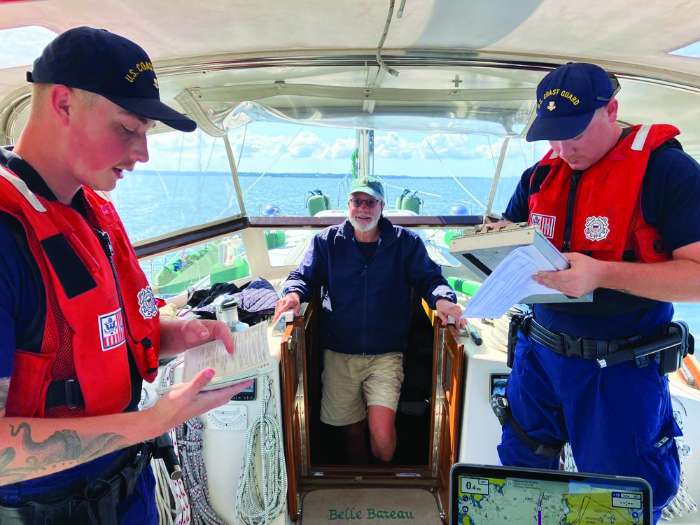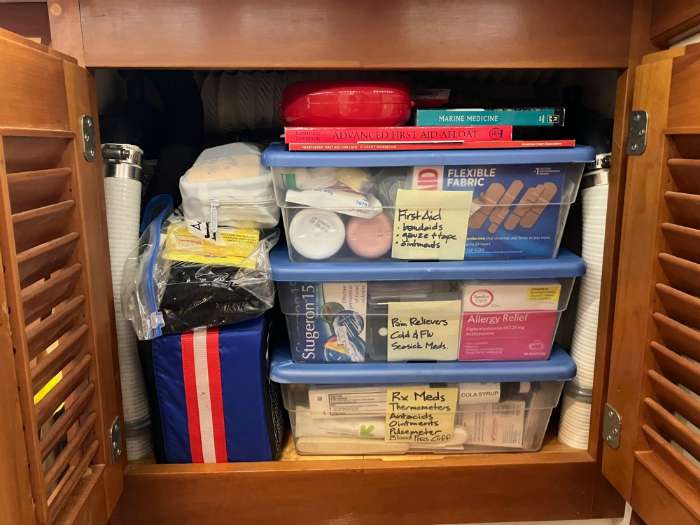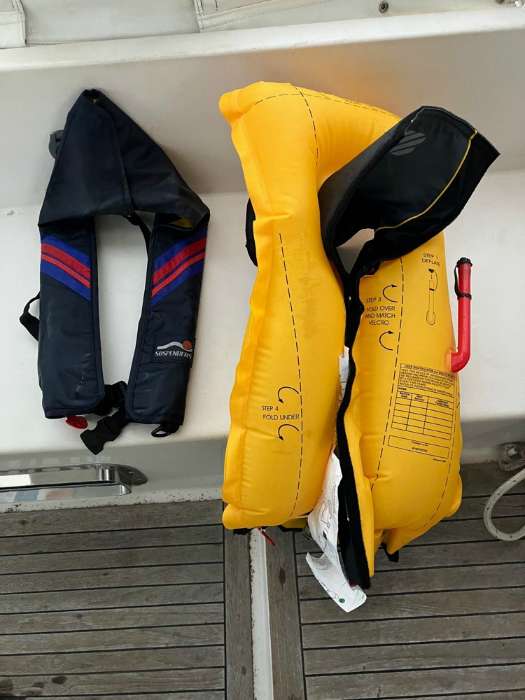It’s Almost-Spring Sailing Safety Checklist Time!
When planning an extended 101-day coastal cruising passage last summer, my husband and I took a critical eye to our boat’s safety equipment. We have always exceeded federal requirements for safety gear, yet wanted to be prepared for unexpected challenges in new waters. We created checklists and labored over several months to complete upgrades, purchase new equipment, and replace expired items.
We thankfully returned to the Chesapeake without using most of our emergency gear, but we did benefit from peace of mind having reliable safety equipment. We also passed a surprise safety inspection boarding by the US Coast Guard (USCG) on Day 80 of our sailing adventure!

As spring approaches, it’s a good time to review your boat’s safety equipment and practices. You might be surprised that some basic items need restocking, and it could be time to buy new gear or add additional safety items.
Federally Required Safety Equipment
The USCG Boating Safety Division recently updated its Boater’s Guide, which contains valuable information about federal laws and equipment requirements for recreational vessels. Required safety gear depends on the type and size of your vessel. For our boat, a Gozzard 44, we have to meet minimum USCG requirements for vessels 40 to 65 feet. The minimum safety requirements for our sailboat include (but are not limited to):
- Personal Flotation Devices (PFD), USCG approved. Recreational vessels must carry one wearable PFD for each person onboard, plus a throwable PFD if the boat exceeds 16 feet. We typically carry four inflatable PFDs as well as four lifejackets and a throwable that stays in the cockpit. We also carry extra cartridges for our inflatables, which proved wise when a PFD stored in our dinghy while we were ashore became submerged due to a storm and inflated.
- Visual Distress Signals. We carry three visual distress signals including flares and non-pyrotechnic devices, such as flashing SOS strobes. We also carry a 12-gauge flare gun in our ditch bag.
- Fire Extinguishers. Approved extinguishers for boats are Class B Marine type and hand portable. Our boat is required to carry one B-II and one B-I (or three B-I’s), but we carry additional. Expiration dates and pressure gauges need to be checked.
- Sound-producing devices. We keep an air horn at the helm and use our VHF to activate the automatic foghorn from our mast-mounted speaker. We also carry the required ship’s bell and several whistles.
- A copy of Inland Navigation Rules. Boats that exceed 39 feet must have an acceptable version of the “Rules of the Road.” We carry a physical copy (book), a digital copy, and a laminated quick reference card.
- Navigation Lights. In addition to running lights, we have a tri-color masthead light for better visibility offshore. We also have a steaming light for motoring.

Medical kit organization on the sailing vessel Belle Bateau before cruising up the East Coast.
Recommended Safety Equipment
After satisfying minimum requirements, many boaters take additional measures to ensure safety. The USCG’s Vessel Safety Check (VSC) includes the following recommendations:
- VHF marine radio. Although not required for recreational vessels under 65 feet, the VHF radio is a priority safety item enabling communication with other boats. Some VHF radios offer a digital selective calling (DSC) feature, which performs like 911 for boaters. Digital selective calling (DSC) sends an automatically formatted distress alert to the USCG, as well as routine calls to other DSC-equipped vessels. We have fixed VHF radios at our helm and nav station, as well as portable VHFs for our dinghy and ditch bag.
- Person Overboard (POB) Gear. In addition to a throwable, we have a tethered Lifesling mounted to our stern rail that may be towed to the POB for rescue.
- Dewatering devices and backup. Although pumps are surprisingly not required, we have three bilge pumps below our cabin sole, including a high-volume one. We also have a manual bilge pump in our cockpit, a portable emergency pump, and several buckets.
- First Aid and Medical Kits. Medical kits should be reviewed regularly for intended passages, discarding expired contents and replenishing as needed. Commercial marine kits are readily available; however, we chose to supplement with additional OTC and prescription medicines as well as other items.
- Marine-Grade Smoke and Carbon Monoxide Detectors. We have both types of detectors in addition to a gas controller and fume detector in our galley for propane use.
- Anchor and Chain/Line. Having an anchor ready to deploy can be a safety feature when engines die or other situations require an emergency stop.
- Nautical Charts. Most of us have become reliant on electronic charts, but devices can lose power. Having paper or duplicate digital charts is a wise practice. Ability to Monitor Weather and Sea Conditions. Before and during passage-making, we compare a variety of apps to anticipate winds, tides, and general weather conditions. We also use weather routing services or subscriptions when sailing offshore.

Updating your personal floatation devices/ lifejackets onboard is crucial for sailing vessels.
Additional Safety Equipment for Consideration
Beyond what the USCG mandates or recommends, additional safety equipment can bring peace of mind. Wallets may feel the pinch though, such as when we paid to recharge our four-person life raft that was thankfully never deployed. Some gear may need updating depending on distance offshore, destinations, rallies or races, and crew preferences. A few key safety upgrades may include:
- AIS, EPIRB, PLB (as described in Safety Series Part 1, January 2024 SpinSheet)
- Strobes and whistles to attach to PFDs
- Jacklines, running bow to stern for attaching PFD tethers when moving on deck
- Life raft and ditch bag
- Essential spare parts including pump impellers, oil and fuel filters, engine belts
- Storm sails and sea anchor/drogue
Regular Maintenance and Drills
Of course, the best way to stay safe on the water is to care for your boat so she can keep you safe. Sailors should regularly inspect and maintain:
- Standing and running rigging, including lifelines
- Condition of sails
- All systems: engine, propellor, fuel, water, electrical, bilges, through-hulls
- Navigation equipment including radar and AIS
- Ground tackle
- Tank capacities and levels before departure, including jerry cans if needed.
- Dinghy and outboard
As you review safety equipment, remember that the Chesapeake region has abundant service providers and agencies that work together to keep our waters safe. For example, the U.S. Coast Guard Auxiliary has certified examiners who will perform a Vessel Safety Check (VSC) for boats up to 65 feet, at the site of your boat. This is a free service, and there are no consequences if you do not pass. Perhaps this is the year to avail yourself of their services? It can’t hurt, but it certainly could help!
Don’t forget to educate yourself and others:
- Hold safety briefings before you leave the dock.
- File a float plan, where you are going, and when you’ll be back.
- Perform person overboard (POB) drills.
- Role-play VHF communications, especially with new crew.
- Practice heaving to in case weather gets dicey.
- Talk through “what ifs.”
- Take safe boating and CPR classes.
- Schedule a free vessel safety check (VSC) with the USCG Auxiliary.
Click for More Info
The US Coast Guard’s Boating Safety website at uscgboating.org offers plentiful resources on safety, vessel safety checks (VSC) and the VSC checklist, lifejacket use, float plans, safety classes, and a printable version of the “USCG Navigation Rules and Regulations” handbook. Click through the tabs on top of the home page to peruse free resources.
About the author: Captain Cheryl Duvall is a USCG Licensed Master, Inland 100 GRT, and is the program director for the Chesapeake Area Professional Captains Association (CAPCA). She recently returned from 101 days at sea from Annapolis to Maine and back on her 1997 Gozzard 44 Belle Bateau: sailingbelle.net.




